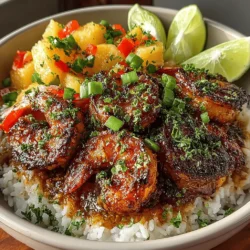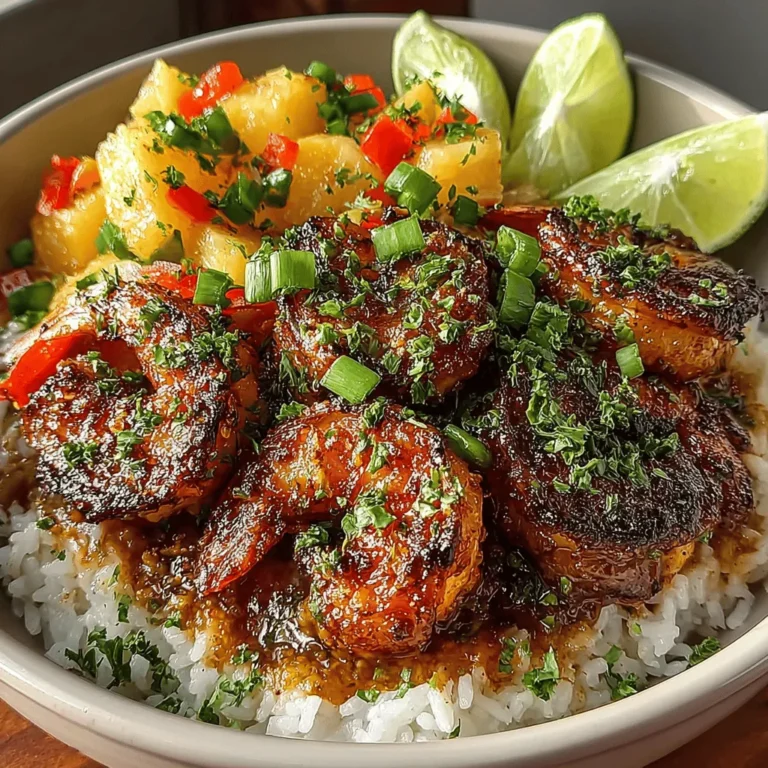Cajun Fiesta Shrimp with Tropical Rice: A Flavorful Journey
Cajun Fiesta Shrimp with Tropical Rice is a vibrant dish that beautifully marries the bold, spicy flavors characteristic of Cajun cuisine with the refreshing, sweet notes of tropical ingredients. This culinary fusion not only tantalizes the palate but also highlights the rich cultural influences that define Cajun cooking. Originating from the Louisiana region, Cajun cuisine is known for its hearty, robust flavors, often featuring a mix of spices and fresh seafood. On the other hand, tropical flavors—especially those derived from fruits like pineapple and creamy coconut—bring a lightness and sweetness that perfectly balance the heat of the Cajun spices.
This dish is ideal for summer gatherings, where its colorful presentation and lively flavors can impress guests at a backyard barbecue or a relaxed dinner party. Alternatively, it can serve as a quick weeknight dinner that transports you to a sun-soaked beach with every bite. The combination of succulent shrimp and fragrant rice, infused with tropical notes, makes this recipe a must-try for anyone looking to elevate their dining experience.
Understanding the Ingredients
To create the perfect Cajun Fiesta Shrimp with Tropical Rice, understanding the ingredients is essential. Each component contributes to the overall flavor and texture of the dish, making it a harmonious blend of tastes.
Jumbo Shrimp
At the heart of this recipe are the jumbo shrimp, which not only provide a satisfying bite but also absorb the flavors of the marinade exceptionally well. When selecting fresh shrimp, look for those that are firm to the touch, have a slight sheen, and carry a clean, oceanic smell. Avoid shrimp that have a strong fishy odor or are discolored. Fresh shrimp can be a delightful addition to your diet, being low in calories and high in protein, making them both a healthy and indulgent choice.
Cajun Seasoning
Cajun seasoning is the backbone of this dish, offering a robust flavor profile that includes ingredients such as paprika, cayenne pepper, garlic powder, onion powder, and various herbs. This spice blend reflects the culinary heritage of Louisiana, where the combination of spices is used to enhance the natural flavors of seafood and vegetables alike. The heat from the cayenne is balanced by the sweetness of the paprika, creating a multi-dimensional flavor that complements the shrimp perfectly.
Jasmine Rice
Jasmine rice is another key ingredient that adds a fragrant aroma and a slightly sticky texture to the dish. This long-grain rice is known for its nutty flavor and fluffy consistency when cooked properly. Its ability to absorb flavors makes it an ideal companion for the tropical elements of this recipe, especially when cooked in coconut milk. The rice’s natural sweetness pairs beautifully with the spicy shrimp, providing a satisfying base for the entire dish.
Coconut Milk
Coconut milk is an essential ingredient that not only contributes a creamy texture but also enhances the dish’s tropical flair. Rich in healthy fats and nutrients, coconut milk provides a subtle sweetness that balances the spices in the Cajun shrimp. If you are looking for alternatives, light coconut milk or even a blend of coconut milk with vegetable broth can provide a similar flavor profile while reducing the overall richness.
Fresh Pineapple
Using fresh pineapple in this recipe is crucial for achieving the best flavor. The natural sweetness and acidity of the pineapple elevate the dish, bringing a refreshing contrast to the spiciness of the shrimp. Canned pineapple can be used in a pinch, but it often lacks the bright flavor and texture that fresh pineapple provides. When selecting a pineapple, look for one that is firm yet slightly soft at the base, with a sweet aroma—indications of ripeness.
Marinating the Shrimp
One of the key steps in preparing Cajun Fiesta Shrimp is marinating the shrimp. This process is essential for infusing the seafood with flavor, ensuring each bite is packed with the dish’s signature spice blend. To create a flavorful marinade, you will need the following ingredients:
– Olive Oil: This not only adds richness to the shrimp but also helps to create a nice sear when cooking.
– Cajun Seasoning, Garlic Powder, and Smoked Paprika: These ingredients work together to create a complex flavor profile that is both spicy and aromatic.
– Lime Juice: The acidity from lime juice enhances the freshness of the shrimp and helps to tenderize the meat.
Step-by-Step Guide to Marinating Shrimp
1. Prepare the Marinade: In a bowl, combine olive oil, Cajun seasoning, garlic powder, smoked paprika, and fresh lime juice. Whisk until well blended.
2. Add the Shrimp: Place the cleaned and deveined jumbo shrimp in the marinade, ensuring each piece is thoroughly coated.
3. Marinate: Cover the bowl with plastic wrap or transfer the shrimp to a resealable plastic bag. Allow the shrimp to marinate in the refrigerator for at least 30 minutes to 1 hour. This will enable the flavors to penetrate the shrimp deeply, resulting in a more flavorful dish.
4. Timing is Key: Avoid marinating shrimp for too long, as the acid in the lime juice can begin to “cook” the shrimp, leading to a rubbery texture.
Preparing the Tropical Rice
Now that the shrimp is marinating, it’s time to prepare the tropical rice, which will serve as the perfect accompaniment to the spicy shrimp. The key to achieving fluffy jasmine rice lies in the rinsing process.
Importance of Rinsing Jasmine Rice
Rinsing jasmine rice is crucial for removing excess starch, which can lead to clumping and a gummy texture when cooked. By rinsing the rice under cold water until the water runs clear, you ensure that the grains separate during cooking, resulting in the ideal fluffy texture that complements the shrimp.
Steps for Cooking the Rice
1. Rinse the Rice: Measure out the desired amount of jasmine rice and rinse it under cold water in a fine-mesh sieve or bowl. Swirl the rice gently with your hand, and continue rinsing until the water is clear.
2. Cooking the Rice: In a pot, combine the rinsed jasmine rice with coconut milk and a pinch of salt. The use of coconut milk instead of water adds a rich, creamy texture and a hint of sweetness that pairs beautifully with the shrimp.
3. Simmer: Bring the mixture to a boil over medium heat, then reduce the heat to low, cover the pot, and let it simmer for about 15-20 minutes, or until the rice is tender and has absorbed the coconut milk.
4. Fluff and Adjust: Once cooked, fluff the rice with a fork and taste for seasoning. You can add more salt or a squeeze of lime juice to enhance the flavors further.
With the shrimp well-marinated and the tropical rice prepared, you are just a few steps away from enjoying this delightful dish. The combination of marinated shrimp and creamy, fragrant rice promises a meal that is as satisfying as it is flavorful. Stay tuned for the next part, where we will delve into the final cooking steps and presentation of this incredible Cajun Fiesta Shrimp with Tropical Rice.
{{image_2}}
Incorporating Pineapple and Vegetables
The addition of pineapple and a medley of colorful vegetables to the tropical rice not only elevates the dish’s flavor profile but also offers a plethora of nutritional benefits. Pineapple, with its natural sweetness and tang, beautifully balances the spiciness of Cajun seasoning, creating a harmonious blend that tantalizes the taste buds. Rich in vitamins C and B6, manganese, and dietary fiber, pineapple contributes to a robust immune system and aids digestion.
Complementing the pineapple, vegetables such as bell peppers, red onions, and peas provide a vibrant array of colors and textures. These ingredients are high in essential vitamins and antioxidants, promoting overall health. The crunchy bell peppers deliver vitamin C, while the peas add protein and fiber, making this dish not only a feast for the eyes but also a nutritious option for any meal. Together, these components create a tropical rice base that is as healthy as it is delicious.
Grilling the Shrimp
Grilling shrimp is a delightful way to enhance their natural sweetness while infusing them with smoky flavor. Here are some essential tips for grilling shrimp to perfection:
Tips for Grilling Shrimp to Perfection
1. Avoiding Common Pitfalls: One of the most frequent mistakes when grilling shrimp is overcooking them. Shrimp cook quickly, and even a minute too long can lead to rubbery results. Keep a close eye on them and remove them from the grill as soon as they turn opaque.
2. Prepping the Grill and Skewering Techniques: Before grilling, preheat your grill to a medium-high temperature (around 400°F). This ensures proper searing and prevents sticking. If using wooden skewers, soak them in water for at least 30 minutes before grilling; this prevents them from burning and helps them hold the shrimp securely.
3. Importance of Soaking Wooden Skewers: The soaking process not only protects the skewers but also allows them to absorb water, which helps keep the shrimp moist during grilling. Metal skewers can be used as well, but ensure they are well-coated with oil to prevent sticking.
4. How to Arrange Shrimp on Skewers for Even Cooking: When skewering shrimp, thread them through the thickest part to ensure even cooking. Aim for about 4-5 shrimp per skewer, ensuring they are close but not crowded. This allows heat to circulate properly and cook each shrimp uniformly.
5. Signs of Perfectly Grilled Shrimp: Perfectly grilled shrimp should be pink and opaque, with a slight char that adds depth to the flavor. They typically take about 2-3 minutes on each side, depending on the size. When you see them curling into a C-shape, that’s a good indicator they’re close to done.
Plating the Dish
Creating a visually stunning presentation can enhance the overall dining experience. Here are some creative serving suggestions for your Cajun Fiesta Shrimp with Tropical Rice:
Creating an Eye-Catching Presentation with Vibrant Colors
Start by placing a generous scoop of tropical rice in the center of the plate. Arrange the grilled shrimp around the rice, showcasing their beautiful caramelized color. To add a pop of color, scatter diced bell peppers and peas around the plate, reflecting the dish’s fresh ingredients. Consider using a ring mold to shape the rice for a more sophisticated look.
Importance of Garnishes for Visual and Flavor Enhancement
Garnishes can elevate your dish from ordinary to extraordinary. Fresh cilantro or parsley sprinkled on top adds a burst of color and a hint of freshness. Lime wedges not only serve as a zesty garnish but also allow your guests to customize their flavor profiles with a squeeze of citrus. A drizzle of coconut cream or a light sauce can add an additional layer of richness.
Tips for Serving: Best Sides or Drinks that Pair Well with the Dish
For sides, consider serving a crisp green salad or grilled vegetables to complement the flavors of the shrimp and rice. A light, refreshing coleslaw with a citrus dressing can also balance the heat of the Cajun seasoning. As for drinks, a chilled glass of white wine or a tropical cocktail, such as a mojito or piña colada, would beautifully enhance the meal experience.
Nutritional Information
Understanding the nutritional benefits of your dish can help you appreciate it even more. Here’s a breakdown of the key nutritional components found in Cajun Fiesta Shrimp with Tropical Rice:
Protein Content from Shrimp
Shrimp is an excellent source of high-quality protein, which is essential for muscle growth and repair. A serving of shrimp provides about 20 grams of protein, making it a great option for those looking to increase their protein intake while keeping calories in check.
Healthy Fats from Coconut Milk
Coconut milk, used in the tropical rice, is rich in healthy fats, particularly medium-chain triglycerides (MCTs), which can boost metabolism and promote fat loss. It also adds a creamy texture and a subtle sweetness to the dish, enhancing its overall appeal.
Vitamins and Minerals from Vegetables and Pineapple
The vegetables and pineapple included in the dish offer a wealth of vitamins and minerals. For instance, bell peppers are high in vitamins A and C, while peas are a good source of iron and vitamin K. Pineapple provides bromelain, an enzyme that aids digestion and may help reduce inflammation.
Discussion on Portion Sizes and Balanced Meal Considerations
While this dish is nutritious, portion control is essential to maintain a balanced diet. A serving size of shrimp (about 4-5 pieces) along with a generous scoop of tropical rice will provide a satisfying meal without excess calories. Pairing it with a side of vegetables or a salad ensures that you’re getting a well-rounded meal rich in essential nutrients.
Cultural Significance of the Dish
Cajun cuisine is deeply rooted in the diverse cultural heritage of Louisiana, influenced by French, African, Spanish, and Native American cooking traditions. This fusion of flavors is celebrated in dishes like Cajun Fiesta Shrimp, which reflect the vibrant history of the region.
Exploration of Cajun Cuisine’s Roots and Its Evolution
Originating from the Acadian settlers, Cajun cooking is characterized by its bold flavors, use of spices, and emphasis on local ingredients. Over the years, it has evolved and incorporated various influences, making it a unique culinary tradition. The use of tropical ingredients in this dish signifies the ongoing evolution of Cajun cuisine, showcasing how it adapts to incorporate new flavors from different cultures.
How Tropical Ingredients Reflect Cultural Exchanges in Cooking
The inclusion of pineapple and coconut milk in Cajun Fiesta Shrimp illustrates how culinary boundaries can blend. These tropical ingredients, often associated with Caribbean cuisine, highlight the cultural exchanges that have occurred over centuries. Such combinations not only enrich the dish but also tell a story of shared experiences and flavors across regions.
The Dish as a Representation of Community and Sharing
Food has a remarkable ability to bring people together, and Cajun cuisine is no exception. The communal aspect of sharing a meal is central to Cajun culture, often celebrated during gatherings and festivals. Cajun Fiesta Shrimp embodies this spirit of sharing, as it is a dish meant to be enjoyed with family and friends.
Conclusion
Cajun Fiesta Shrimp with Tropical Rice is a celebration of flavors, colors, and culture. The dish not only delights the palate with its spicy, sweet, and savory notes but also nourishes the body with its wholesome ingredients. Its vibrant presentation makes it a feast for the eyes, while the rich cultural background gives it depth and significance.
Cooking is an art that brings joy and fosters connections, whether you’re sharing a meal with loved ones or exploring new culinary territories. I encourage you to try this recipe, experiment with variations, and make it your own. Embrace the flavors of Cajun cuisine and the tropical elements that make this dish truly special. Happy cooking!


